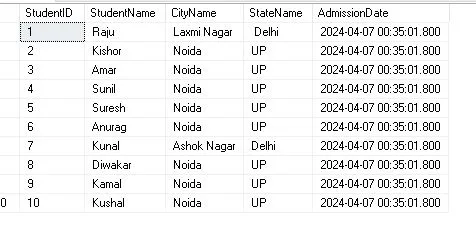SQL temp tables are valuable for storing temporary data during a session or transaction. Database administration and development efficiency can be significantly increased by knowing their subtleties, benefits, and best practices.
Table of Contents
Introduction
During a session or transaction, temporary data can be stored and managed using SQL temp tables. They are perfect for storing interim findings, temporary data sets, or intricate computations because they provide a transient storage option that lasts only for the session or transaction.
A Glimpse into History
Since the beginning of SQL databases, temporary tables have been a component. They have developed database technology to satisfy the increasing needs of administrators and developers for effective temporary data management.
Advantages of SQL Temp Tables
Advantages of using SQL Temp Tables are given below:
Temporary Storage
During a query run or session, temporary tables offer a practical means of storing and managing interim results. They enable you to divide intricate questions into more manageable, straightforward steps.
Scope Restricted to Current Session or Query Batch
Temporary tables are only accessible inside the context of the session or batch in which they are generated because their scope is limited to the current session or query batch. It offers isolation between various sessions or queries and lessens the likelihood of naming conflicts.
Decreased Locking and Blocking
Temporary tables can help reduce locking and blocking problems in multi-user setups by offering a separate workspace for every session. Since temp tables are scoped to each session, concurrent sessions can operate independently without interfering.
Optimization Opportunities
When working with temp tables, SQL Server’s query optimizer can provide more effective execution plans than intricate subqueries or derived tables. Because temp tables offer statistics and indexing features, the optimizer can decide how best to execute queries.
Performance and Reuse
By allowing temp tables to be utilized again during a session or query batch, interim results don’t need to be recalculated. It can enhance the efficiency of queries, particularly intricate ones that require repeated calculations.
You may also like this article : Step-by-Step Guide to Install SQL Server 2019 on Linux
Disadvantages of SQL Temp Tables
Disadvantages of using SQL Temp Tables are given below:
Overhead
Memory and CPU resources are used to create and maintain during creating and maintaining temp tables. Tempo tables can affect performance if they are misused or overused, even though they are helpful for processing and organizing data.
Resource Consumption
Temporary tables use memory and disk space, mainly when dealing with big datasets. Resource contention and excessive or improper temp table formation can negatively impact the system’s performance.
Dependency on TempDB
All sessions and databases on the SQL Server instance share the TempDB database containing the temp tables. Excessive use of temp tables might affect the performance of other sessions and databases and cause TempDB contention.
Possibility of Name Collisions
If several sessions or batches use a temp table name, naming conflicts may arise since temp tables are scoped to the session. Adhering to strict naming conventions is essential to prevent unexpected outcomes.
Data Integrity Issues
Unlike permanent tables, temporary tables offer a different degree of data integrity. They are not subject to limitations like primary keys, foreign keys, or unique constraints, which, if handled correctly, might result in data consistency or integrity problems.
Temporary versus Permanent Table Comparison
SQL Temp Table: Types, Syntax, and Example
Local temporary tables and global temporary tables are the two main categories of temporary tables in SQL Server. For each type, the syntax and an example are as follows:
1. Local Temporary Tables
These are only displayed during the active session and are automatically removed at its conclusion.
Syntax:
CREATE TABLE #TempTableName (
ColumnName1 DataType Constraints,
ColumnName2 DataType Constraints,
...
ColumnNameN DataType Constraints
);Example:
-- To Create a Local Temp Table In SQL Server
CREATE TABLE #TempStudents (
StudentID INT IDENTITY(1,1) PRIMARY KEY,
StudentName NVARCHAR(100) NOT NULL,
CityName NVARCHAR(100),
StateName NVARCHAR(100),
AdmissionDate DateTime DEFAULT GETDATE()
);
-- Insert a few sample data in the Local Temp Table
INSERT INTO #TempStudents (StudentName, CityName, StateName)
VALUES ('Raju', 'Laxmi Nagar',' Delhi'),
('Kishor', 'Noida','UP'),
('Amar', 'Noida','UP'),
('Sunil', 'Noida','UP'),
('Suresh', 'Noida','UP'),
('Anurag', 'Noida','UP'),
('Kunal', 'Ashok Nagar','Delhi'),
('Diwakar', 'Noida','UP'),
('Kamal', 'Noida','UP'),
('Kushal', 'Noida','UP');
-- To Fetch Data from the Local Temp Table
SELECT * FROM #TempStudents;
-- To Drop the Global Temp Table
DROP TABLE #TempStudents;
2. Global Temporary Tables
These are shown in every session and removed after the last one that references them.
Syntax:
CREATE TABLE ##TempTableName (
ColumnName1 DataType Constraints,
ColumnName2 DataType Constraints,
...
ColumnNameN DataType Constraints
);Example:
-- T-SQL Command to create a Global Temp Table in SQL Server
CREATE TABLE ##TempOrders (
OrderID INT IDENTITY(1,1) PRIMARY KEY,
ItemName NVARCHAR(100) NOT NULL,
ItemQuantity DECIMAL(10,2) NOT NULL,
ItemPrice DECIMAL(10, 2) NOT NULL,
OrderDate DateTime DEFAULT GETDATE()
);
-- Insert a few sample data in the Global Temp Table
INSERT INTO ##TempOrders (ItemName, ItemQuantity, ItemPrice)
VALUES ('Reynolds Pen - Blue', 100, 25.99),
('Reynolds Pen - Black', 100, 26.99),
('Parker Pen', 25, 86.99),
('Cello Pen', 25, 16.99),
('Montex Pen', 25, 17.99);
-- To Fetch Data From the Global Temp Table
SELECT * FROM ##TempOrders;
-- To Drop the Global Temp Table
DROP TABLE ##TempOrders;
Temp Table Performance Tuning Tips
Tips for optimizing query performance and improving overall database efficiency for developers using SQL Server pertain to temp table performance tweaking. Here are some pointers:
For Developers
Reduce the Volume of Data
Just get the relevant rows and columns from the temporary table to reduce the amount of data transferred and processing overhead.
Curtail Use of Temp Tables
Refrain from making needless temporary tables. Use inline views, Common Table Expressions (CTEs), or derived tables whenever feasible.
Appropriate Indexing
Examine query execution plans to find areas where temp table indexes could be improved. If you often utilize columns in filters, joins, and order by clauses, think about indexing those columns.
Don’t Use Cursors
Avoid using cursors with temp tables, as they may cause performance to deteriorate. Whenever possible, employ set-based operations instead.
Keep Your Temp Tables Small
Filter data as early in the query as feasible to keep temp tables minimal. It enhances overall performance and uses less memory and storage space.
Maximize the Use of Temp Tables in Stored Procedures
Examine and improve any stored routines that use temp tables for optimal performance. Consider dividing complicated processes into smaller, easier-to-manage components.
Steer clear of table variables
Temp tables should be preferred over table variables when dealing with huge datasets. Table variables lack statistics, but temp tables can gain from query optimization.
For Administrators
Configuring the tempDB
Keep an eye on the TempDB file’s size and ensure enough space is allocated to avoid auto-growth occurrences, which might affect performance. For best results, think about storing TempDB on fast storage.
Location of the TempDB File
To balance the I/O demand and avoid bottlenecks, distribute the TempDB data files equally among the disks. Follow recommended practices to adapt the location of the TempDB file to the number of processor cores.
Track The Use of Temp Tables
Track temp table utilization with performance monitoring tools to find queries that create too many temp tables. Examine and improve the queries that are generating performance problems.
TempDB Conflict
Look for problems with TempDB contention, including allocation or latch contention. To reduce contention, modify the workload patterns or TempDB setup parameters as necessary.
Continual Upkeep
Schedule routine maintenance operations, including index maintenance, statistics updates, and TempDB file defragmentation, to guarantee the best possible performance from temp tables and TempDB as a whole.
Resource Observation
Monitor the server’s CPU, memory, and disk input/output to spot resource bottlenecks influencing temp table performance. Address resource limitations by taking corrective action.
Common Issues with SQL Temp Table
There are several reasons why SQL temporary tables frequently have problems. A few of the most common issues are given below for your reference:
Collisions by Name
Errors or unusual behavior may result from temporary table names colliding with those of other temporary tables or permanent tables that already exist.
Mismatch in Scope
When scope management goes wrong, temporary tables may become unusable or be discarded too soon, leading to queries failing or giving false results.
Use of Resources
The TempDB database’s memory and disk space can significantly deplete by large or overuse of temporary tables, affecting system performance.
Problems with concurrency
Deadlocks, blocking, and resource congestion can result from concurrent sessions or transactions fighting for access to the same temporary table.
Fragmentation
Creating and deleting temporary tables frequently can result in tempDB fragmentation, impairing performance, and increasing disk I/O.
Growth in Transaction Logs
Transaction log growth and possible disk space difficulties can result from operations utilizing big temporary tables, generating significant transaction log entries.
Issues with Indexing
Temporary table indexing choices limit query performance, particularly for complex queries with joins and sorting.
Data Integrity Issues
Inadequate referential integrity checks and constraints on temporary tables may lead to inconsistent data or inaccurate query results.
Converting implicit data types
Implicit data type conversion between columns in temporary tables and other objects may result in data truncation or conversion issues.
Functionality Restrictions
Temporary tables are limited in some situations because they might not support certain features or functions available for permanent tables.
Query Plan Inefficiencies
Poor performance and longer execution times can result from query strategies that could be better when they involve temporary tables.
Overhead for Maintenance
Managing temporary tables—including creating, populating, and deleting them—can add expense and administrative complications, especially in high-concurrency contexts.
FAQs
Qns: Can temporary tables be indexed?
Ans: It is possible to index temporary tables to enhance query performance.
Qns: Do temporary tables stay in place between sessions?
Ans: No, temporary tables are only meant to be used within a given session; they are automatically deleted at that point.
Qns: Is it possible for many sessions to access the same temporary global table?
Ans: Yes, all sessions can see the global temporary tables.
Qns: Do temporary tables have schema constraints?
Ans: The answer is no; temporary tables are not schema-bound.
Qns: Is it possible to use temporary tables in stored procedures?
Ans: In stored processes, temporary tables are indeed usable.
Qns: Can temporary tables support limitations?
Ans: Limitations like primary and foreign keys are impossible for temporary tables.
Qns: Do transient tables have to be transactional?
Ans: In short, temporary tables participate in transactions and are transactional.
Qns: Is it possible to back up temporary tables?
Ans: Since temporary tables are only created for the life of a session or transaction, the answer is no; they are not backed up.
Qns: Does the allocation of storage for temporary tables apply?
Ans: While they are in use, temporary tables use memory and disk space.
Conclusion
In database administration, SQL temporary tables are essential resources because they offer a versatile and effective way to handle temporary data during sessions or transactions. This article covers all the nuances of temporary tables, including their benefits, use cases, construction syntax, and performance optimization advice.
Temporary tables have many advantages, such as making complex data manipulations easier, increasing code readability, and optimizing query efficiency. They are essential when data must be stored temporarily, like complicated data conversions, reporting, or analysis operations.
Other Important Articles
A Powerful Merge Statement in SQL Server


Hello my friend!
I want to say that this article is amazing, great written and include approximately all important infos. I’d like to look more posts like this.